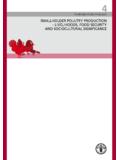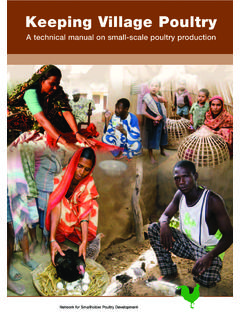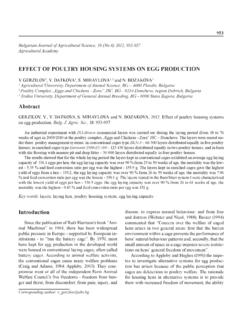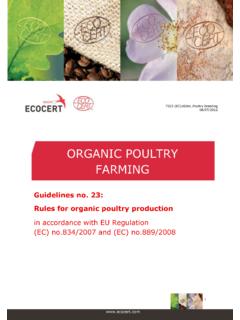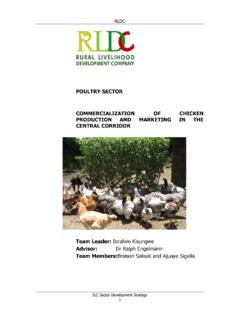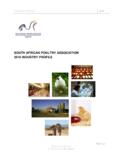Transcription of POULTRY PRODUCTION - Poultry farming in kenya
1 POULTRY PRODUCTION FOREWORD. POULTRY farming makes a substantial contribution to household food security throughout the developing world. Helps diversify incomes and provides quality food, energy, fertilizers and renewable asset in over 80% of the rural households. However small scale producers are constrained by such challenges: o Poor access to markets, goods and services o Lack of knowledge and skills, weak institutions, inappropriate technology. o Poor breeds, feeds and vaccines POULTRY farming is an income generating project as the main goal in POULTRY keeping. Eggs can provide a regular albeit small income while the sale of live birds while slaughtered birds provides a bit more flexible source of cash as required. A study on income generation in transmigrate farming system in an African country showed that farming POULTRY accounted about 53% of the total income and was used for food, school fees and unexpected expenses like medicines. Flock composition is heavily biased towards chickens in Africa and with more ducks in E.
2 Africa and S. America. OBJECTIVES of POULTRY farming 1. Home consumption 2. Cultural reasons 3. Income generation PRODUCTION SYSTEMS POULTRY farming are kept under a wide range of conditions which can be classified into one of four broad PRODUCTION systems. 1. Free range extensive system 2. Backyard extensive system 3. Semi intensive 4. Intensive range In free range condition, the birds are not confined and can scavenge for food over a wide area. Rudimentary shelters may be provided and these may or may not be used. The birds may roost outside usually in trees and nests in the bush. The flock contains birds of different species and varying ages. extensive POULTRY are housed only at night but allowed free range during the day. They are usually fed a handful of grain in the morning and evening to supplement scavenging. intensive system These are combination of the extensive and intensive systems where birds are confined to a certain area with access to shelter.
3 Commonly found in urban and peri-urban and in rural situations. In the run system, the birds are confined in an enclosed area outside during the day and housed at night. Feed and water are available in the house to avoid wastage by rain , wind and by wild animals. Categories of semi-intensive system I. Ark system II. Fold system Ark-Where the POULTRY are confined (for security against predators) in a building mounted on two rails or skids (usually wooden) which enables it to be moved from one place to another with a draught power. A typical size is 2* to hold about 40birds. Fold-unit with a space allowance (stock density) for adult birds of typically 3-4 birds per square meter (birds/M2) both inside and (at least this) outside. This fold unit is usually small enough to be moved by one person. Neither of the two systems is commonly found in developing countries. systems These systems are used by medium and large scale commercial enterprises and are also used at the household level.
4 Birds are fully confined either in houses or in cages Capital outlay is higher and the birds are totally dependent on their owners for all their requirements. PRODUCTION however is higher. TYPES OF INTENSIVE SYSTEMS I. Deep litter system II. Slatted floor system III. Battery cage system Deep litter system Birds are fully confined (with floor space allowance of 3-4 birds/m2 within a house, but can move around freely). The floor is covered with deep litter (5-10 cm deep layer of grain husks of either maize, rice, straw, wood shavings or similarly absorbent but non toxic material). The fully enclosed system protects the birds from thieves and predators, and is suitable for specially selected commercial breeds of eggs or meat producing POULTRY (layers, breeder flocks and broilers.) Slatted floor system Wire or wooden slatted floors are used instead of deep litter, which allow stocking rates to be increased to five birds/m2 of floor space. Birds have reduced contact with feaces and are allowed some freedom of movement.
5 Battery cage systems This is usually used for laying birds, which are kept throughout their productive life in cages. There is initial high capital investment and the system is mostly confined to large scale commercial egg layer operations. Intensive system of rearing indigenous chickens commercially is uncommon. Conclusions Over the last decade, the consumption of POULTRY products in developing countries has grown by per annum, faster than that of human population growth and has created a great increase in demand. POULTRY farming has the potential to satisfy at least this demand through increased productivity and reduced wastage and losses. And for this to remain sustainable adapted breeds and better management of stock health and local affordable feed resources must be within reach. Not excluding technology which needs not to be so sophiscated however technology in inputs must be inexpensive for economic considerations. Further more emphasis on genetic improvement usually through the introduction of Exotic genes, improved feeds with no effect of birds of low genetic potential.
6 Note 1. Flock composition depends on the objectives and the purpose of the POULTRY enterprise. Note 2. For breeding, the ratio of cork to hen of about 5:1 is common but sexes are retained for 150-300 days for the purpose of culling or selling. SPECIES AND BREEDS I. Chickens II. Guinea fowl (Numididae) originated in west Africa III. Ducks (inc Muscovy ducks) (carina moschata) IV. Pigeons (Columba livea) in Europe V. Turkey(Meleagrididae)in Latin America VI. Pheasants (phasianidae) in Asia VII. Common ducks (anas) in Europe VIII. Geese (Anser) in Asia CHICKENS Chickens originated in Asia and were introduced to the rest of the world by sailors and traders. Categorized into; 2. Indigenous Hybrid The new hybrids are widely distributed and are present I n every county in tropics, even in the most remote villages. The hybrids have been carefully selected and specialized solely for the PRODUCTION of either meat or eggs. This end product specialized hybrid strains are unsuitable for breeding purposes, especially for mixing with local village scavenger stock as their have very low mothering ability and broodiness.
7 For the small holder keeping hybrids means considerable changes are required in management there may be expensive for the following reasons: 1. All replacement day-old chicks must be purchased 2. Hatchery chicks require artificial brooding and special starting feeds 3. Hybrids require higher quality balanced feed for optimum meat and egg PRODUCTION 4. Requires more careful veterinary hygiene and diseases management 5. Egg laying hybrid hens require supplementary artificial light (a steadingly increasing day length up to 17hrs of total light per day)for optimum profitable PRODUCTION . -The meat and egg from intensively raised hybrid stock are considered by many traditional consumers thus offer to pay a higher price for village produced POULTRY meat and eggs. INDIGENOUS (kienyeji chicken). Nowadays indigenous village chickens are the results of centuries of cross breeding with exotic breeds and random breeding within the flock. As a result it s impossible to standardize the characteristics and productivity performance of indigenous chickens.
8 Characteristics like adult body weight and egg weight vary considerably among indigenous chicken population through reproductive traits like the no, of laying seasons per year no. of eggs per clutch and hatchability are more consistent. Indigenous village birds in Ethiopia attain sexual maturity at an average age of 7 months (214 days) and lay about 36 eggs. GENERAL MANAGEMENT Basic requirements for POULTRY housing are; Space Ventilation Light Protection(from weather and predators) I. Space This density of birds per unit area, it s the most important basic principle in housing as the space available determines the number and the type of POULTRY that can be kept. For instance in deep litter system house measures 6m by 11m can hold about 200 laying birds at a stock density of 3birds/m2 Older system measures stock density in ft2/bird which is the inverse of birds/m2 used in metric system. The recommended floor and perching space for the 3 main types of chicken is shown below.
9 Chicken type Floor space birds/m2 Floor space ft2/bird Perch space per bird layer 3 25cm (10 inch) Dual purpose 4 20cm (8inch) meat 4-5 15-20cm (6-8inch) Note; Hen groups are comfortable at a stock density of 3-4 birds per m2 . If more space is allowed a greater variety of behavior can be expressed Less space creates stressed social behavior, allowing diseases vulnerability and cannibalism and leaving weaker birds deprived of feeds or perch space. Individual birds need more room for normal behavior and adequate exercise than the 22birds/m2 ( ) density currently used in commercial laying. III. Ventilation This is the airflow in and outside the housing. Building with open sides is ideal, otherwise cross-ventilation at bird level should be allowed in for the through the floor level inlets and in a direction to allow the prevailing wind to blow across the width of the building. An air mass between the sidewalls of a POULTRY house resists being moved even across an open-ended side building.
10 The wider the building, the more the resistant it is to air movement Building over 8m (26ft) wide have a significant greater problem because of this inherent property of air to resist movement, so should not exceed 8m. Heat stress is a significant constraint to successful PRODUCTION and can lead to death. Though birds can withstand several degrees below freezing, their do not tolerate temperatures over 400c,this depends on relative humidity prevailing at that time, POULTRY do not have sweat glands and must cool themselves by panting out water in their breath, which is evaporative cooling, when the humidity is too high this cooling mechanism doesn t work very well. In high temperatures build house facing prevailing winds. Ground cover can also reduce reflected heat, shade should be provided especially if there is little air movement or if humidity is high. When confined in higher temperatures POULTRY becomes heat stressed and irritable and may begin peck at one another which can lead to cannibalism.
